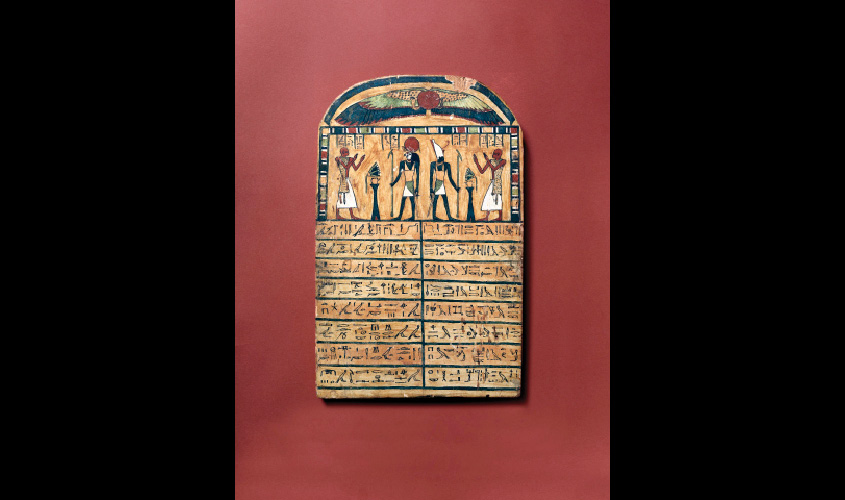A chart at the entrance of Emoglyphs: Picture-Writing From Hieroglyphs to the Emoji exhibition at the Israel Museum in Jerusalem pairs a column of hieroglyphs with a column of emojis. The similarities are uncanny, reports Isabel Kershner.
The sleek figures, kohl-rimmed eyes and offerings to the gods etched on ancient Egypt’s temples and tombs are enjoying a kind of graphic afterlife, reincarnated in the tears of joy, clinking beer mugs and burger emojis of digital messaging.
An exhibition at the Israel Museum in Jerusalem, Emoglyphs: Picture-Writing From Hieroglyphs to the Emoji, highlights the seemingly obvious, but also complicated, relationship between the iconic communication system from antiquity and the lingua franca of the cyber age.
A visual and linguistic exercise in time travel, Emoglyphs juxtaposes the once indecipherable pictogram writing of ancient Egypt, which first developed about 5,000 years ago, with the more accessible and universal usage of pictograms that originated in Japan in the late 1990s.
“It was always hard to explain how to read hieroglyphics,” said Shirly Ben Dor Evian, an Egyptologist and the show’s curator. “In recent years it’s become easier to explain because people are writing with pictures. So I started looking into emoji.”
The first thing she noticed, she said, was that some emojis look like hieroglyphs.
A chart at the entrance of the exhibition pairs a column of hieroglyphs with a column of emojis. The similarities are uncanny: There’s no need for translation.
The Egyptian depiction of a slender, generic dog closely resembles the emoji of a prancing canine in profile. A duck (often used as a generic for a winged creature in ancient Egyptian) reappears thousands of years later as an almost identical, left-facing emoji duck. And the “emoji man dancing” strikes a similar pose to a hieroglyph of a dancing man, one arm raised and with little but a purple disco suit and a loin cloth from 3,000 years ago to distinguish between them.
The exhibition, in a small gallery in the museum’s Bronfman Archaeology Wing, has more than 60 ancient Egyptian artifacts on display; most are from the museum’s collection, and many of them on view for the first time. Visitors can quiz themselves on their understanding of emojis and their newly acquired knowledge of hieroglyphs on interactive screens. Data on the differing interpretation of some emojis will be gathered as part of a survey.
The two systems may have common features, but there are also deep and complex differences.
Hieroglyphics was a complete written language, and while even an illiterate person could recognize and understand some basic symbols, the scribes worked according to strict rules and had to be highly skilled. Ancient Egyptian inscriptions eventually morphed into the dry efficiency of the first alphabet of around 20 characters, which could be more easily taught and executed, leading to an explosion in communications.
“What’s happened now,” said Ben Dor Evian, who has a hieroglyph app on her cellphone, “is that it is easier to click on an emoji than to write a whole word.”
Emojis often serve as emotional shorthand—think smiley blowing a heart kiss to soften a message or send love, or a winking face to signal sarcasm—filling an expressive void that text messages may fail to convey.
In ancient Egyptian writing and art, the image of a scarab, or dung beetle, expressed a whole concept of the afterlife and rebirth and was used in inscriptions as the verb “to become.” Hieroglyphics also had ways of adding context in the form of a set of mute symbols known as “classifiers.” A Libyan throw stick could, for example, be used to denote foreignness.
Both systems appear to perceive the power of pictograms. An ancient spell inscribed on a scarab to ease the journey of the dead
With the beginnings of research into the field of emoji, Egyptologists, cognitive linguists and communication experts have started debating the similarities between the two communication systems and what sets them apart.
Some have hailed emoji as a new language. One enthusiast produced a crowdsourced and crowdfunded emoji version of Herman Melville’s classic Moby-Dick titled Emoji Dick. In 2015, Oxford Dictionaries chose the “face with tears of joy” emoji as its word of the year, saying it best represented “the ethos, mood and preoccupations” of the period.
But Chaim Noy, a professor in the school of communications at Bar Ilan University near Tel Aviv who teaches a course on emoji “because it attracts students,” considers it simplistic and populist to speak of emoji as a language, viewing it as a kind of body-language supplement to text.
An expert in museum studies as well, Noy said there was nevertheless “drama” in the exhibition, which runs through 12 October, juxtaposing the high culture of the museum and ancient Egypt against the bottom-up, lowbrow culture of emoji.
“It’s a bit provocative; it brushes off the tired, dusty image,” he said.
Emojis may just be the latest manifestation in a long history of pictographic writing and signage, from prehistoric cave painting to advertising logos. Cave dwellers used strong colors to make their wall images tens of thousands of years ago. “Those are super-emoji, more emoji than emoji,” Noy said, adding, “They invented the emoji.”
The exhibition allows the public a rare chance to connect with the ancient world in a way that is relevant to life today, said Orly Goldwasser, head of Egyptology at the Hebrew University of Jerusalem, adding that the Egyptians faced some of the same problems as emoji users and developers.
On their own, words and pictures can only go so far in conveying abstract ideas. So the advent of the alphabet, Goldwasser said, was both “a great victory and a great loss.”
“It destroyed the picture,” she said of the alphabet. But now, she added, “All the yearning for the picture has come back through the emoji. So emoji is filling a void, a lack, in the dryness of the word.”© 2019 The New York Times

